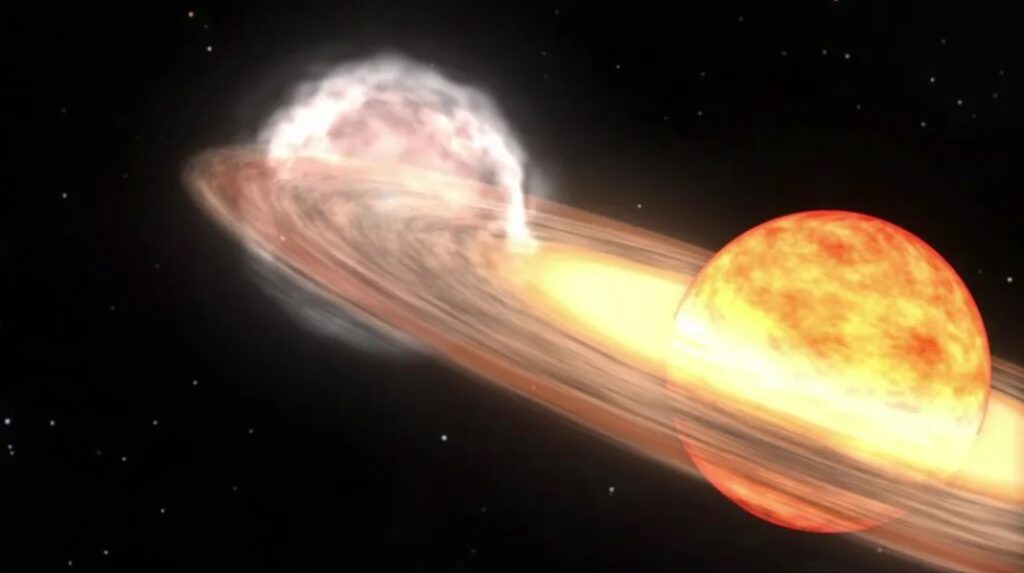
An artist's rendering of T Coronae Borealis | NASA/Goddard Space Flight Center
As you may have heard, stargazers may be treated to an unusual sight in the night sky at some point in the coming months: a nova, which will appear to the naked eye as a “new star” for a few weeks before it fades back to its normal brightness. But what exactly is this phenomenon, and what can we expect to see?
What is a nova?
The visible manifestation of a nova is a brief, sudden increase in a star’s brightness that can make it among the brightest objects in the sky, aside from the Sun and Moon. The word “nova” comes from the Latin phrase for “new star,” as novas can appear suddenly as new stars in the sky.
What causes a star to suddenly brighten as a nova?
Many stars are members of pairs, known as “binaries,” where two stars orbit one another. In such a system, if both stars are at or near the end of their life cycle, one star is a white dwarf and the other evolves into a red giant (a stage near the end of a star’s life, just before it becomes a white dwarf), the white dwarf can start to gravitationally attract some of the gas from the red giant’s atmosphere. This gas is mostly hydrogen, and accumulates on the surface of the intensely hot white dwarf. When enough gas has built up, the increased pressure and temperature from the pile up of material explosively ignites the gas, in a nuclear explosion on the star’s surface. This is the phenomenon we observe in our sky as a nova. After the bright flash, the nova will fade, likely dimming beyond visibility over the following couple of weeks as the hydrogen is processed into helium and heavier elements.
The potential nova will occur within the binary star T Coronae Borealis (also known as the Blaze Star or simply T CrB), which is located within the constellation Coronae Borealis. T CrB A, the white dwarf in the star pair, belongs to a special class of novas known as recurrent novas, meaning that it has exploded multiple times over the last 200 years. It was first discovered by astronomer John Birmingham during an outburst in 1866, though it had been observed earlier in a quiescent period and classified as a 10th magnitude star, roughly 40 times fainter than is typically visible to the unaided eye. It may have also been observed during outburst periods in 1217 and in 1787.
When will the nova explosion happen?
The nova was last seen in outburst in 1946, and its behavior over the past decade appears strikingly similar to what astronomers observed just before the last outburst. If this pattern persists, some researchers believe that the nova event could occur by September of this year.
Astronomers aren’t sure exactly when the explosion will occur, and opinions on the approximate timeline are split. Some believe it could happen within the next few months, others within the next few years.
Lowell astronomer Dr. Gerard van Belle has been observing T CrB over the past six months using a 20-inch telescope located on Mars Hill near downtown Flagstaff, AZ, gathering data on the binary system’s current “quiet phase.” His goal is to precisely measure the different wavelengths of light emitted by the stars as the white dwarf approaches its “outburst” phase and explodes, so that astronomers can make more accurate predictions on when T CrB and possibly other similar recurrent novae will explode again in the future.
What will the nova look like?
While the exploding star won’t dominate the night sky as one might imagine, it will still be a very novel thing to see. Of the recurrent novae, T CrB is the nearest and brightest, and doesn’t require a telescope to see in outburst. To the naked eye, the nova will appear as a new bright star in the sky, in a spot where a star wasn’t visible previously. “These sorts of cosmic events are striking because we’re not used to ‘new’ stars showing up in the sky,” says Dr. van Belle. “It will be about as bright as the North Star, the 50th brightest star in all the sky. These events are important for our life here on Earth, because the majority of the light metal lithium currently in the Milky Way is manufactured in the nuclear reactions at the heart of these nova explosions.” Lithium is used in everyday items like batteries, medications, alloys, and glass.
Where should I look to see the nova?
To find the nova, use the asterism “Arc to Arcturus”. Find the Big Dipper, then follow the arc of its “handle” to Arcturus, the first bright star you’ll see. Arcturus is part of the diamond-shaped constellation Boötes, the Herdsman. To the right of Boötes, you’ll see a U-shaped curve of stars: Corona Borealis. If T Crb goes nova, it will appear just underneath the left end of the curve. The outburst will be brief — once it erupts, it will be visible to the naked eye for a little less than a week.